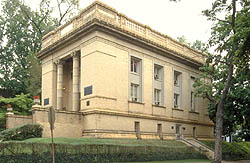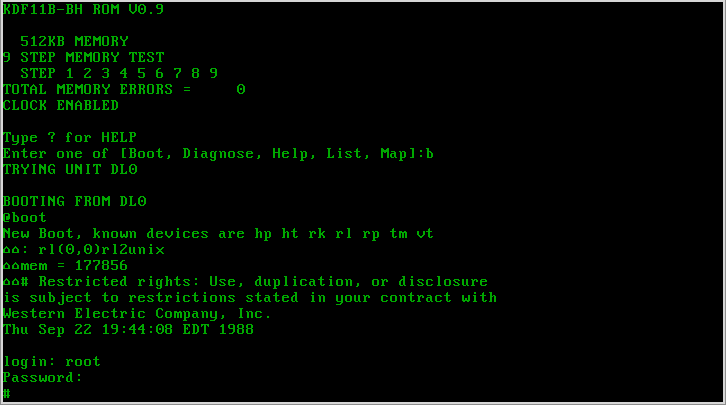|
Diff3
diff3 is a Unix utility to compare three files and show any differences among them. diff3 can also merge files, implementing a three-way merge. History and implementations originally appeared in Version 7 Unix of 1979. A very similar version was found in Berkeley Software Distribution (BSD) and was inherited into OpenBSD and probably Solaris. On most modern Unix-like systems, even BSD-derived ones like FreeBSD and NetBSD, the diff3 provided is GNU's version in diffutils (formerly ''GNU Tools''). This version has the ability to merge files on its own without relying on . It internally invokes to do the comparison, but can use any other compatible tool too. The command is available as a separate package for Microsoft Windows as part of the UnxUtils collection of native Win32 ports of common GNU Unix-like utilities. "Diff3" has also become a generic name for the three-way-merge algorithm, specifically one based on reconciling two different diffs stemming from the first sour ... [...More Info...] [...Related Items...] OR: [Wikipedia] [Google] [Baidu] |
Diff
In computing, the utility diff is a data comparison tool that computes and displays the differences between the contents of files. Unlike edit distance notions used for other purposes, diff is line-oriented rather than character-oriented, but it is like Levenshtein distance in that it tries to determine the smallest set of deletions and insertions to create one file from the other. The utility displays the changes in one of several standard formats, such that both humans or computers can parse the changes, and use them for patching. Typically, ''diff'' is used to show the changes between two versions of the same file. Modern implementations also support binary files. The output is called a "diff", or a patch, since the output can be applied with the Unix program . The output of similar file comparison utilities is also called a "diff"; like the use of the word "grep" for describing the act of searching, the word ''diff'' became a generic term for calculating data difference a ... [...More Info...] [...Related Items...] OR: [Wikipedia] [Google] [Baidu] |
Ed (Unix)
(pronounced as distinct letters, ) is a line editor for Unix and Unix-like operating systems. It was one of the first parts of the Unix operating system that was developed, in August 1969. It remains part of the POSIX and Open Group standards for Unix-based operating systems, alongside the more sophisticated full-screen editor vi. History and influence The ed text editor was one of the first three key elements of the Unix operating system—assembler, editor, and shell—developed by Ken Thompson in August 1969 on a PDP-7 at AT&T Bell Labs. Many features of ed came from the qed text editor developed at Thompson's alma mater University of California, Berkeley. Thompson was very familiar with qed, and had reimplemented it on the CTSS and Multics systems. Thompson's versions of qed were notable as the first to implement regular expressions. Regular expressions are also implemented in ed, though their implementation is considerably less general than that in qed. Dennis M. ... [...More Info...] [...Related Items...] OR: [Wikipedia] [Google] [Baidu] |
Porting
In software engineering, porting is the process of adapting software for the purpose of achieving some form of execution in a computing environment that is different from the one that a given program (meant for such execution) was originally designed for (e.g., different CPU, operating system, or third party library). The term is also used when software/hardware is changed to make them usable in different environments. Software is ''portable'' when the cost of porting it to a new platform is significantly less than the cost of writing it from scratch. The lower the cost of porting software relative to its implementation cost, the more portable it is said to be. Etymology The term "port" is derived from the Latin '' portāre'', meaning "to carry". When code is not compatible with a particular operating system or architecture, the code must be "carried" to the new system. The term is not generally applied to the process of adapting software to run with less memory on the sam ... [...More Info...] [...Related Items...] OR: [Wikipedia] [Google] [Baidu] |
Windows API
The Windows API, informally WinAPI, is Microsoft's core set of application programming interfaces (APIs) available in the Microsoft Windows operating systems. The name Windows API collectively refers to several different platform implementations that are often referred to by their own names (for example, Win32 API); see the versions section. Almost all Windows programs interact with the Windows API. On the Windows NT line of operating systems, a small number (such as programs started early in the Windows startup process) use the Native API. Developer support is available in the form of a software development kit, Microsoft Windows SDK, providing documentation and tools needed to build software based on the Windows API and associated Windows interfaces. The Windows API (Win32) is focused mainly on the programming language C in that its exposed functions and data structures are described in that language in recent versions of its documentation. However, the API may be used by an ... [...More Info...] [...Related Items...] OR: [Wikipedia] [Google] [Baidu] |
Native (computing)
In computing, native software or data-formats are those that were designed to run on a particular operating system. In a more technical sense, native code is code written specifically for a certain processor. In contrast, cross-platform software can be run on multiple operating systems and/or computer architectures. For example, a Game Boy receives its software through a cartridge, which contains code that runs natively on the Game Boy. The only way to run this code on another processor is to use an emulator, which simulates an actual Game Boy. This usually comes at the cost of speed. Applications Something running on a computer natively means that it is running without any external layer requiring fewer software layers. For example, in Microsoft Windows the Native API is an application programming interface specific for Windows NT kernel, which can be used to give access to some kernel functions, which cannot be directly accessed through a more universal Windows API. ... [...More Info...] [...Related Items...] OR: [Wikipedia] [Google] [Baidu] |
UnxUtils
UnxUtils is a collection of ports of common GNU Unix-like utilities to native Win32, with executables only depending on the Microsoft C- runtime msvcrt.dll. The collection was last updated externally on April 15, 2003, by Karl M. Syring. The most recent release package available was an open-source project, UnxUtils at SourceForge, with the latest binary release in March, 2007 (though the files within are dated from the year 2000). The independent distribution included a main zip archive (UnxUtils.zip, 3,365,638 bytes) complemented by more recent updates (UnxUpdates.zip, 878,847 bytes, brought some binaries up to year 2003), but the SourceForge project has no UnxUpdates.zip package. An alternative source of Unix-like utilities for Windows is GnuWin32; it has later versions of many programs, but requires supporting files (e.g. DLLs) in many cases. The utilities included are: *agrep.exe * ansi2knr.exe * basename.exe * bc.exe *bison.exe *bunzip2.exe * bzip2.exe *bzip2recov ... [...More Info...] [...Related Items...] OR: [Wikipedia] [Google] [Baidu] |
Microsoft Windows
Windows is a group of several Proprietary software, proprietary graphical user interface, graphical operating system families developed and marketed by Microsoft. Each family caters to a certain sector of the computing industry. For example, Windows NT for consumers, Windows Server for servers, and Windows IoT for embedded systems. Defunct Windows families include Windows 9x, Windows Mobile, and Windows Phone. The first version of Windows was released on November 20, 1985, as a graphical operating system shell for MS-DOS in response to the growing interest in graphical user interfaces (GUIs). Windows is the most popular desktop operating system in the world, with Usage share of operating systems, 75% market share , according to StatCounter. However, Windows is not the most used operating system when including both mobile and desktop OSes, due to Android (operating system), Android's massive growth. , the most recent version of Windows is Windows 11 for consumer Personal compu ... [...More Info...] [...Related Items...] OR: [Wikipedia] [Google] [Baidu] |
AT&T Bell Laboratories
Nokia Bell Labs, originally named Bell Telephone Laboratories (1925–1984), then AT&T Bell Laboratories (1984–1996) and Bell Labs Innovations (1996–2007), is an American industrial Research and development, research and scientific development S.A. (corporation), company owned by multinational company Nokia. With headquarters located in Murray Hill, New Jersey, Murray Hill, New Jersey, the company operates several laboratories in the United States and around the world. Researchers working at Bell Laboratories are credited with the development of radio astronomy, the transistor, the laser, the photovoltaic cell, the charge-coupled device (CCD), information theory, the Unix operating system, and the programming languages B (programming language), B, C (programming language), C, C++, S (programming language), S, SNOBOL, AWK, AMPL, and others. Nine Nobel Prizes have been awarded for work completed at Bell Laboratories. Bell Labs had its origin in the complex corporate organizat ... [...More Info...] [...Related Items...] OR: [Wikipedia] [Google] [Baidu] |
Unix
Unix (; trademarked as UNIX) is a family of multitasking, multiuser computer operating systems that derive from the original AT&T Unix, whose development started in 1969 at the Bell Labs research center by Ken Thompson, Dennis Ritchie, and others. Initially intended for use inside the Bell System, AT&T licensed Unix to outside parties in the late 1970s, leading to a variety of both academic and commercial Unix variants from vendors including University of California, Berkeley ( BSD), Microsoft ( Xenix), Sun Microsystems (SunOS/ Solaris), HP/ HPE (HP-UX), and IBM ( AIX). In the early 1990s, AT&T sold its rights in Unix to Novell, which then sold the UNIX trademark to The Open Group, an industry consortium founded in 1996. The Open Group allows the use of the mark for certified operating systems that comply with the Single UNIX Specification (SUS). Unix systems are characterized by a modular design that is sometimes called the " Unix philosophy". According to this p ... [...More Info...] [...Related Items...] OR: [Wikipedia] [Google] [Baidu] |
Berkeley Software Distribution
The Berkeley Software Distribution or Berkeley Standard Distribution (BSD) is a discontinued operating system based on Research Unix, developed and distributed by the Computer Systems Research Group (CSRG) at the University of California, Berkeley. The term "BSD" commonly refers to its open-source descendants, including FreeBSD, OpenBSD, NetBSD, and DragonFly BSD. BSD was initially called Berkeley Unix because it was based on the source code of the original Unix developed at Bell Labs. In the 1980s, BSD was widely adopted by workstation vendors in the form of proprietary Unix variants such as DEC Ultrix and Sun Microsystems SunOS due to its permissive licensing and familiarity to many technology company founders and engineers. Although these proprietary BSD derivatives were largely superseded in the 1990s by UNIX SVR4 and OSF/1, later releases provided the basis for several open-source operating systems including FreeBSD, OpenBSD, NetBSD, DragonFly BSD, Darwin, and Tr ... [...More Info...] [...Related Items...] OR: [Wikipedia] [Google] [Baidu] |
Version 7 Unix
Seventh Edition Unix, also called Version 7 Unix, Version 7 or just V7, was an important early release of the Unix operating system. V7, released in 1979, was the last Bell Laboratories release to see widespread distribution before the commercialization of Unix by AT&T Corporation in the early 1980s. V7 was originally developed for Digital Equipment Corporation's PDP-11 minicomputers and was later ported to other platforms. Overview Unix versions from Bell Labs were designated by the edition of the user's manual with which they were accompanied. Released in 1979, the Seventh Edition was preceded by Sixth Edition, which was the first version licensed to commercial users. Development of the Research Unix line continued with the Eighth Edition, which incorporated development from 4.1BSD, through the Tenth Edition, after which the Bell Labs researchers concentrated on developing Plan 9. V7 was the first readily portable version of Unix. As this was the era of minicomputers, w ... [...More Info...] [...Related Items...] OR: [Wikipedia] [Google] [Baidu] |



